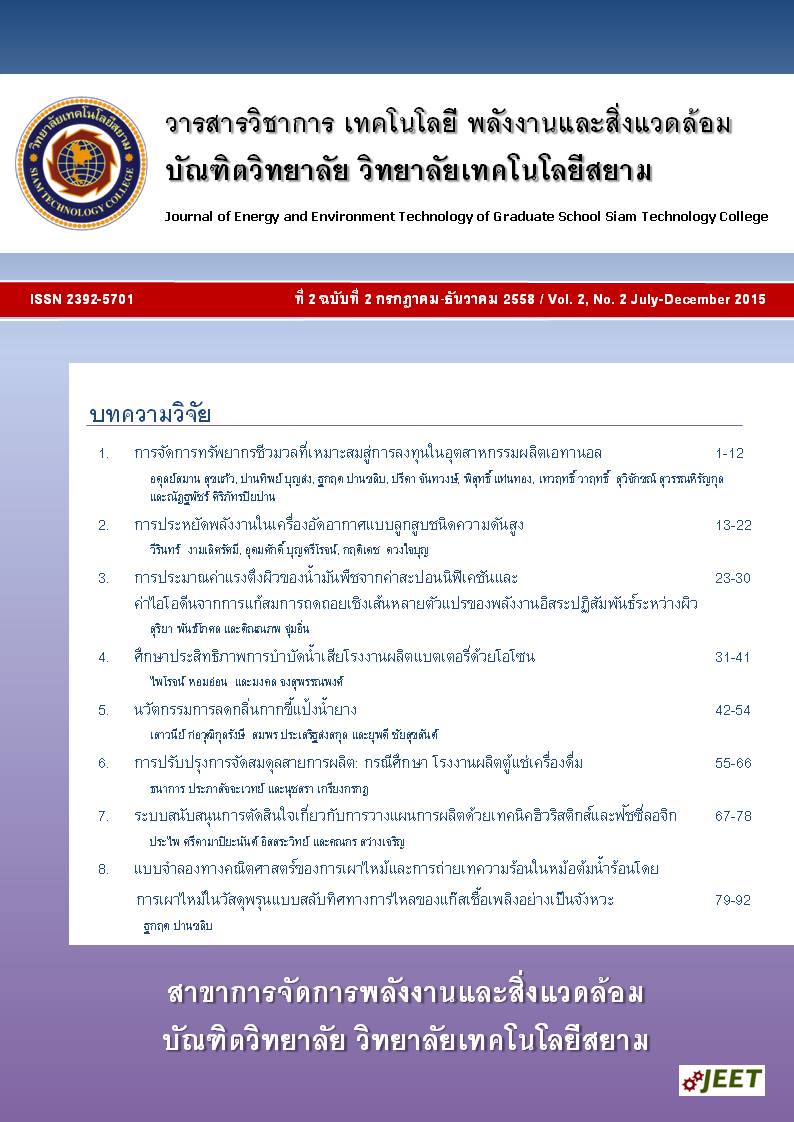The optimal of Biomass Resource Management to ethanol production of industrial Investment
Main Article Content
Abstract
The objective of this study is to assess cost effectiveness in ethanol production by using 4 biomass namely Rice straw (Oryza sativa L.), Grass(Chylocheilichthys apogon), Oil palm (Elaeis guineensis Jacq.) and Water hyacinth (Eichhornia crassipes). Net Present Value (NPV) and Break Event Point (PB) were studied and they find that the 4 biomass could create benefit approximately
400,000 baht per year in the first year. The payback period is approximately only five months to seven months. But rice straw was profitable crop which has NPV and PB in the first year as 604,800 baht, 391,144.31 and 0.41 years, respectively. The comparison was best compared to other plants in the same period. However, if four types of biomass were properly managed, it would be a mean to support robustness and sustainability of the community. It can also reduce agricultural waste and weeds. It can solve the energy crisis as an alternative avenue.
Article Details
เนื้อหาและข่อมูลในบทความที่ลงตีพิมพ์ในวารสารวิชาการ เทคโนโลยี พลังงาน และสิ่งแวดล้อม บัณฑิตวิทยาลัย วิทยาลัยเทคโนโลยีสยาม ถือเป็นข้อคิดเห็นและความรับผิดชอบของผู้เขียนบทความโดยตรง ซึ่งกองบรรณาธิการวารสารไม่จำเป็นต้องเห็นด้วย หรือว่าร่วมรับผิดชอบใด ๆ
บทความ ข้อมูล เนื้อหา รูปภาพ ฯลฯ ที่ได้รับการตีพิมพ์ในวารสารวิชาการ เทคโนโลยี พลังงาน และสิ่งแวดล้อม บัณฑิตวิทยาลัย วิทยาลัยเทคโนโลยีสยาม ถือเป็นลิขสิทธิ์ของวารสารวิชาการ เทคโนโลยี พลังงาน และสิ่งแวดล้อม บัณฑิตวิทยาลัย วิทยาลัยเทคโนโลยีสยาม หากบุคคล หรือหน่วยงานใดต้องการนำทั้งหมด หรือส่วนหนึ่งส่วนใดไปเผยแพร่ต่อ หรือเพื่อกระทำการใด ๆ จะต้องได้รับอนุญาต เป็นลายลักษณ์อักษรจากวารสารวิชาการ เทคโนโลยี พลังงาน และสิ่งแวดล้อม บัณฑิตวิทยาลัย วิทยาลัยเทคโนโลยีสยาม เท่านั้น
References
[2] Pongpiachan, S., Tipmanee, D., Khumsup, C., Kittikoon, I., and Hirunyatrakul, P. (2015). Assessing risks to adults and preschool children posed by PM2.5-bound polycyclic aromatic hydrocarbons (PAHs) during a biomass burning episode in Northern Thailand. Science of The Total Environment, 508(0), 435-444.
[3] Huang, Y.F., Shih, C.H., Chiueh, P.T., and Lo, S.L. (2015). Microwave co-pyrolysis of sewage sludge and rice straw. Energy, 87(0), 638-644.
[4] Singh, R., Srivastava, V., Chaudhary, K., Gupta, P., Prakash, A. and Balagurumurthy, B. (2015). Conversion of rice straw to monomeric phenols under supercritical methanol and ethanol. Bioresource Technology, 188(0), 280-286.
[5] Murphy, H.T., O’connell, D.A., Raison, R.J., Warden, A.C., Booth, T.H., Herr, A., Braid, A.L., Crawford, D.F., Hayward, J.A., Jovanovic, T., Mcivor, J.G., O’connor, M.H., Poole, M. L., Prestwidge, D., Raisbeck-Brown, N. and Rye, L. (2015). Biomass production for sustainable aviation fuels: A regional case study in queensland. Renewable and Sustainable Energy Reviews, 44(0), 738-750.
[6] Wall, D.M., Straccialini, B., Allen, E., Nolan, P., Herrmann, C., O’kiely, P. and Murphy, J.D. (2015). Investigation of effect of particle size and rumen fluid addition on specific methane yields of high lignocellulose grass silage. Bioresource Technology, 192(0), 266-271.
[7] Zainudin, M.H.M., Hassan, M.A., Tokura, M. and Shirai, Y. (2013). Indigenous cellulolytic and hemicellulolytic bacteria enhanced rapid co-composting of lignocellulose oil palm empty fruit bunch with palm oil mill effluent anaerobic sludge. Bioresource Technology, 147(0), 632-635.
[8] Xia, A., Cheng, J., Song, W., Yu, C., Zhou, J. and Cen, K. (2013). Enhancing enzymatic saccharification of water hyacinth through microwave heating with dilute acid pretreatment for biomass energy utilization. Energy, 61(0), 158-166.
[9] Lopes, D.G., Da Silva, E.P., Pinto, C.S., Neves Jr, N.P., Camargo, J.C., Ferreira, P.F.P., Furlan, A.L. and Lopes, D.G. (2012). Technical and economic analysis of a power supply system based on ethanol reforming and pemfc. Renewable Energy, 45(0), 205-212.
[10] Schmit, T.M., Luo, J. and Tauer, L.W. (2009). Ethanol plant investment using net present value and real options analyses. Biomass and Bioenergy, 33(10), 1442-1451.
[11] Di-Luccio, M., Borges, C.P. and Alves, T.L.M. (2002). Economic analysis of ethanol and fructose production by selective fermentation coupled to pervaporation: Effect of membrane costs on process economics. Desalination, 147(1–3), 161-166.
[12] Fasahati, P., Yi, G. and Liu, J. (2012). Techno-economic analysis of ethanol production from marine biomass, in: A.K. Iftekhar and S. Rajagopalan (Eds) Computer aided chemical engineering. (vol. Volume 31), Elsevier, 780-784.
[13] Kelloway, A., Tsapatsis, M. and Daoutidis, P. (2015). Techno-economic analysis of ethanol-selective membranes for corn ethanol-water separation, in: J. K. H. Krist V. Gernaey and G. Rafiqul (Eds) Computer aided chemical engineering. (vol. Volume 37), Elsevier, 365-370.
[14] Vučurović, D.G., Dodić, S.N., Popov, S.D., Dodić, J.M. and Grahovac, J.A. (2012). Process model and economic analysis of ethanol production from sugar beet raw juice as part of the cleaner production concept. Bioresource Technology, 104(0), 367-372.
[15] ศรีอุบล ทองประดิษฐ์, อดุลย์สมาน สุขแก้ว, ธีระพงค์ หมวดศรี, ปาริฉัตร นิลอุปถัมภ์ และ น้อมจิตต์ แก้วไทย อันเดร (2558). การประเมินผลความคุ้มค่าของการผลิตเอทานอลจากกากน้ำตาลด้วยเชื้อยีสต์
Saccharomyces cerevisiae TISTR 5339 เพื่อการลงทุนในระดับชุมชน, การประชุมวิชาการเครือข่ายพลังงานแห่งประเทศไทยครั้งที่ 11, มหาวิทยาลัยเทคโนโลยีพระจอมเกล้าธนบุรี, หน้า 1,344-1352.


